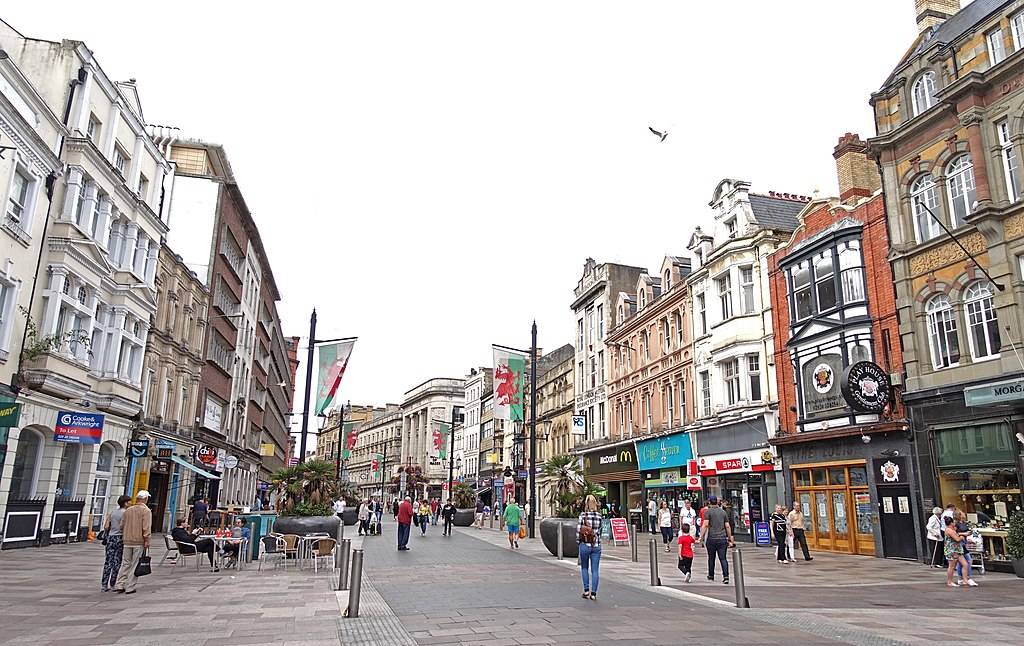St. Mary’s Street in Cardiff, Wales, has stood in some form or another for hundreds of years. It is recognized by many as being the “main street” of the capital city, and is synonymous with the history of Cardiff itself. It was for decades a congested thoroughfare of cars passing from the highway which came into the city on its north side, to the docks and Cardiff Bay to its south.
In 2010, it was completely pedestrianized.
The History
The first modern efforts for a pedestrianized St. Mary’s Street came in the late 1960s, with the formulation of a frankly absurd proposal called “Centreplan 70.” This plan is mindboggling to look back at, and would have seen, amongst other developments: every church in the city center being uprooted and relocated brick-by-brick to all be next to each other in a precinct, sinking the road and making a highway underneath the city center (way before Elon got that idea), and making every street in the city a covered walkway to protect from the rain. Unsurprisingly, this proposal never came to fruition, but the desire to transform the city center and make it more accessible to pedestrians only grew.
Fast forward to 2008, and an emboldened city council launched a full consultation on the way forward for the city center. A report by out-of-town consultants recommended a full pedestrianization of St. Mary’s Street, along with a revamped city center bus network. Two months later, the council gave its approval for pedestrianization, in conjunction with a sustainable transport vision aimed at making Cardiff Wales’ first “sustainable travel town.”
The Reception
As you might imagine, the full pedestrianization of a large car-dominated street right in the city center was hardly a harmonious topic. Business owners expressed concerns about drop-off in visits to their stores and restaurants, and many were concerned that the traffic currently going through St. Mary’s Street would simply be converted into heavier traffic along parallel streets, which were narrower and less well equipped to deal with that flow.
Nonetheless, the council moved forward, and in November of 2011, the pedestrianization was completed, and the main north/south transport route through the city, as the plaque commemorating the occasion stated, was “handed over to the people of Cardiff and visitors to the city for their use and enjoyment.”
So, did it work?
Well, simply put, yes. In the first month since the opening of a new shopping center and the pedestrianization of the city center, Cardiff saw weekly footfall figures soar. If you were to walk down St. Mary’s Street today, you would see a broad, buzzing downtown which puts pedestrians first. Restaurants are able to open out onto the streets, cyclists and pedestrians can travel safely, and without worry of being run down by a careless driver, and there isn’t the constant buzz and fumes of passing vehicles. This is supported by studies into pedestrianization, which have noted in other historic city centers that “huge decreases to the levels of environmental degradation have been found in the central area and such benefits accumulate to a large number of people who live, work or undertake leisure activities on the pedestrianized roads.”

What can Chapel Hill learn?
The most iconic and celebrated Franklin Street traditions and moments happen when the streets are closed to cars. Whether that is the rush of fans after an historic win at the Dean Dome, or Halloween on Franklin Street (admittedly poorly attended this year, which was a shame).
Franklin Street is ripe for pedestrianization. The businesses and restaurants could extend out onto the street, and every game day fans and students could safely wander through the town. Cyclists could utilize a super-highway, and the median could have trees which cool the air temperature in the summer, as well as contributing to the environment.
Of course, this couldn’t be an isolated solution. As with Cardiff, it would have to be coupled with an upgraded and vitalized transit plan. Looking at the recent unveiling of Raleigh’s Bus Rapid Transit program, and with the plans for Chapel Hill’s own on the horizon, this future is viable. It would also have to be coupled with more housing options, as in order to sustain a pedestrianized town center, that town center has to be walkable from nearby housing solutions.
Perhaps it won’t happen, and Franklin Street won’t become the rolling proto-European boulevarde that I’m envisaging. But if there were ever a street that was calling out for it, Franklin would be the one.
